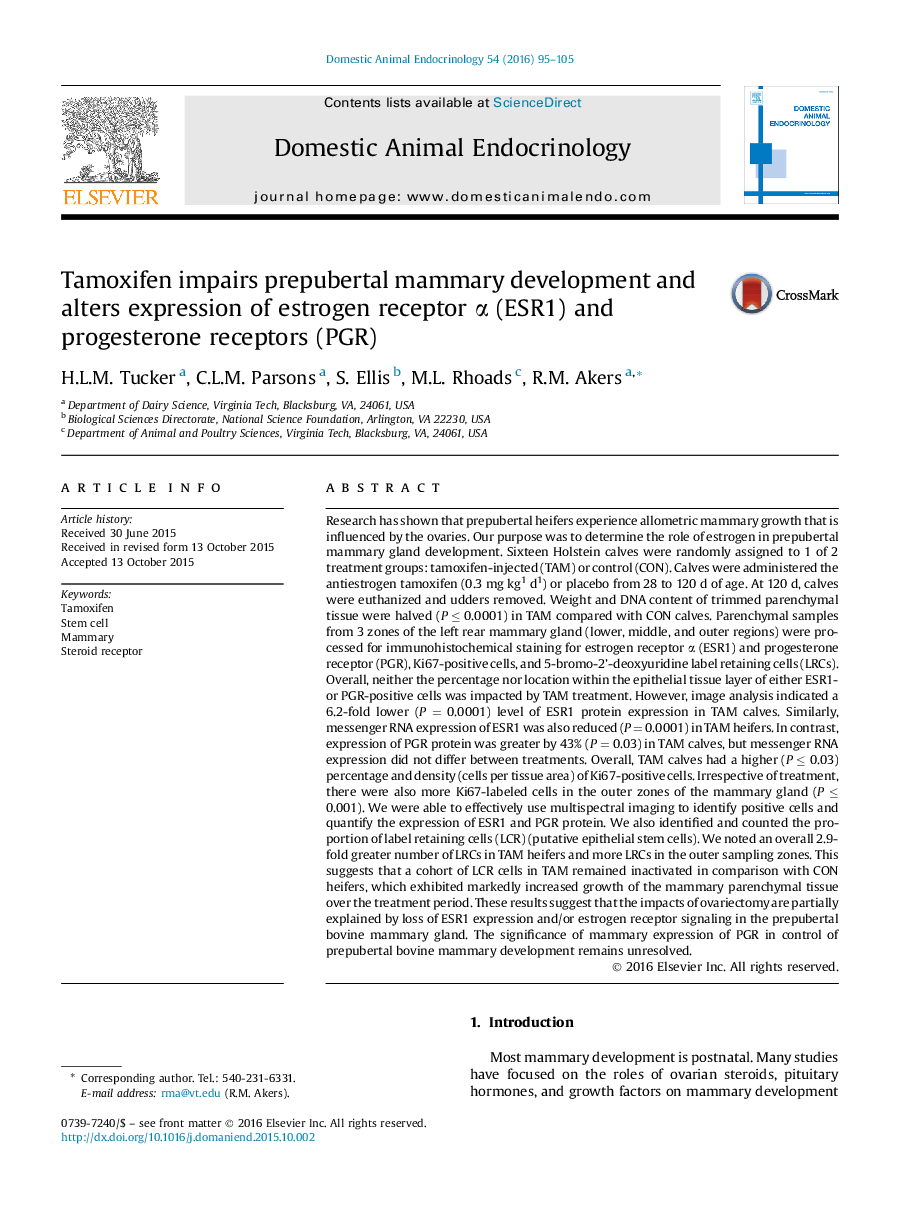| کد مقاله | کد نشریه | سال انتشار | مقاله انگلیسی | نسخه تمام متن |
|---|---|---|---|---|
| 2393434 | 1551505 | 2016 | 11 صفحه PDF | دانلود رایگان |

• The impact of the ovary and presumably ovarian-derived estrogen prior to puberty is not well defined.
• We evaluated the impact of the antiestrogen tamoxifen on mammary development and expression of ESR1 and PGR in prepubertal heifers.
• Tamoxifen marked reduced mammary development, PGR expression was modestly greater but ESR1 expression was markedly reduced by tamoxifen.
• Putative bovine mammary stem cells (LRC) averaged less than 0.3% of total epithelial cells but were greater after tamoxifen and in the outer region.
• Our findings suggest that expression of ESR1 is especially important in control of prepubertal bovine mammary development.
Research has shown that prepubertal heifers experience allometric mammary growth that is influenced by the ovaries. Our purpose was to determine the role of estrogen in prepubertal mammary gland development. Sixteen Holstein calves were randomly assigned to 1 of 2 treatment groups: tamoxifen-injected (TAM) or control (CON). Calves were administered the antiestrogen tamoxifen (0.3 mg kg1 d1) or placebo from 28 to 120 d of age. At 120 d, calves were euthanized and udders removed. Weight and DNA content of trimmed parenchymal tissue were halved (P ≤ 0.0001) in TAM compared with CON calves. Parenchymal samples from 3 zones of the left rear mammary gland (lower, middle, and outer regions) were processed for immunohistochemical staining for estrogen receptor α (ESR1) and progesterone receptor (PGR), Ki67-positive cells, and 5-bromo-2'-deoxyuridine label retaining cells (LRCs). Overall, neither the percentage nor location within the epithelial tissue layer of either ESR1- or PGR-positive cells was impacted by TAM treatment. However, image analysis indicated a 6.2-fold lower (P = 0.0001) level of ESR1 protein expression in TAM calves. Similarly, messenger RNA expression of ESR1 was also reduced (P = 0.0001) in TAM heifers. In contrast, expression of PGR protein was greater by 43% (P = 0.03) in TAM calves, but messenger RNA expression did not differ between treatments. Overall, TAM calves had a higher (P ≤ 0.03) percentage and density (cells per tissue area) of Ki67-positive cells. Irrespective of treatment, there were also more Ki67-labeled cells in the outer zones of the mammary gland (P ≤ 0.001). We were able to effectively use multispectral imaging to identify positive cells and quantify the expression of ESR1 and PGR protein. We also identified and counted the proportion of label retaining cells (LCR) (putative epithelial stem cells). We noted an overall 2.9-fold greater number of LRCs in TAM heifers and more LRCs in the outer sampling zones. This suggests that a cohort of LCR cells in TAM remained inactivated in comparison with CON heifers, which exhibited markedly increased growth of the mammary parenchymal tissue over the treatment period. These results suggest that the impacts of ovariectomy are partially explained by loss of ESR1 expression and/or estrogen receptor signaling in the prepubertal bovine mammary gland. The significance of mammary expression of PGR in control of prepubertal bovine mammary development remains unresolved.
Journal: Domestic Animal Endocrinology - Volume 54, January 2016, Pages 95–105